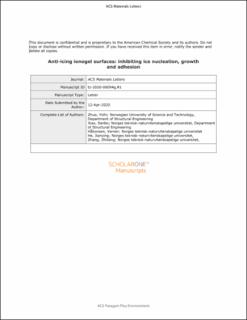| dc.contributor.author | Zhuo, Yizhi | |
| dc.contributor.author | Xiao, Senbo | |
| dc.contributor.author | Håkonsen, Verner | |
| dc.contributor.author | He, Jianying | |
| dc.contributor.author | Zhang, Zhiliang | |
| dc.date.accessioned | 2020-08-25T09:22:45Z | |
| dc.date.available | 2020-08-25T09:22:45Z | |
| dc.date.created | 2020-04-29T10:54:42Z | |
| dc.date.issued | 2020 | |
| dc.identifier.issn | 2639-4979 | |
| dc.identifier.uri | https://hdl.handle.net/11250/2673850 | |
| dc.description.abstract | Delaying ice and frost formation is one of the key strategies to mitigate the hazards induced by ice accretion. The current surfaces for delaying ice formation rely on restricting heterogeneous ice nucleation, which fails in practical application because dust and impurities from the environment can serve as undesired nucleation sites and, thus, promote ice nucleation. Herein, ionogel surfaces are prepared to not only inhibit ice nucleation but also control ice growth. At −20 °C, the prepared surface enables an unconventional inward ice growth from the water droplet–air interface, resulting in a spherical cap ice rather than a normal pointy cap ice. Both experiments and molecular simulations confirm that the prepared ionogel surface can efficiently generate an interfacial liquid layer thanks to the inward ice growth and the presence of ionic liquid. Such non-frozen interfacial liquid layer is desired for lowering ice adhesion and preventing frost formation. Consequently, the ionogel surface exhibits exceptional anti-frost abilities under cold humid environment (−20 °C, importing gas 60% RH at 20 °C). | en_US |
| dc.language.iso | eng | en_US |
| dc.publisher | American Chemical Society | en_US |
| dc.title | Anti-icing ionogel surfaces: inhibiting ice nucleation, growth and adhesion | en_US |
| dc.type | Peer reviewed | en_US |
| dc.type | Journal article | en_US |
| dc.description.version | acceptedVersion | en_US |
| dc.source.journal | ACS Materials Letters | en_US |
| dc.identifier.doi | 10.1021/acsmaterialslett.0c00094 | |
| dc.identifier.cristin | 1808583 | |
| dc.relation.project | Norges forskningsråd: 255507 | en_US |
| dc.relation.project | Norges forskningsråd: 250990 | en_US |
| dc.relation.project | Norges forskningsråd: 245963 | en_US |
| dc.description.localcode | Locked until 30.4.2021 due to copyright restrictions. This document is the Accepted Manuscript version of a Published Work that appeared in final form in [JournalTitle], copyright © American Chemical Society after peer review and technical editing by the publisher. To access the final edited and published work see http://dx.doi.org/10.1021/acsmaterialslett.0c00094 | en_US |
| cristin.ispublished | false | |
| cristin.fulltext | postprint | |
| cristin.qualitycode | 1 | |
